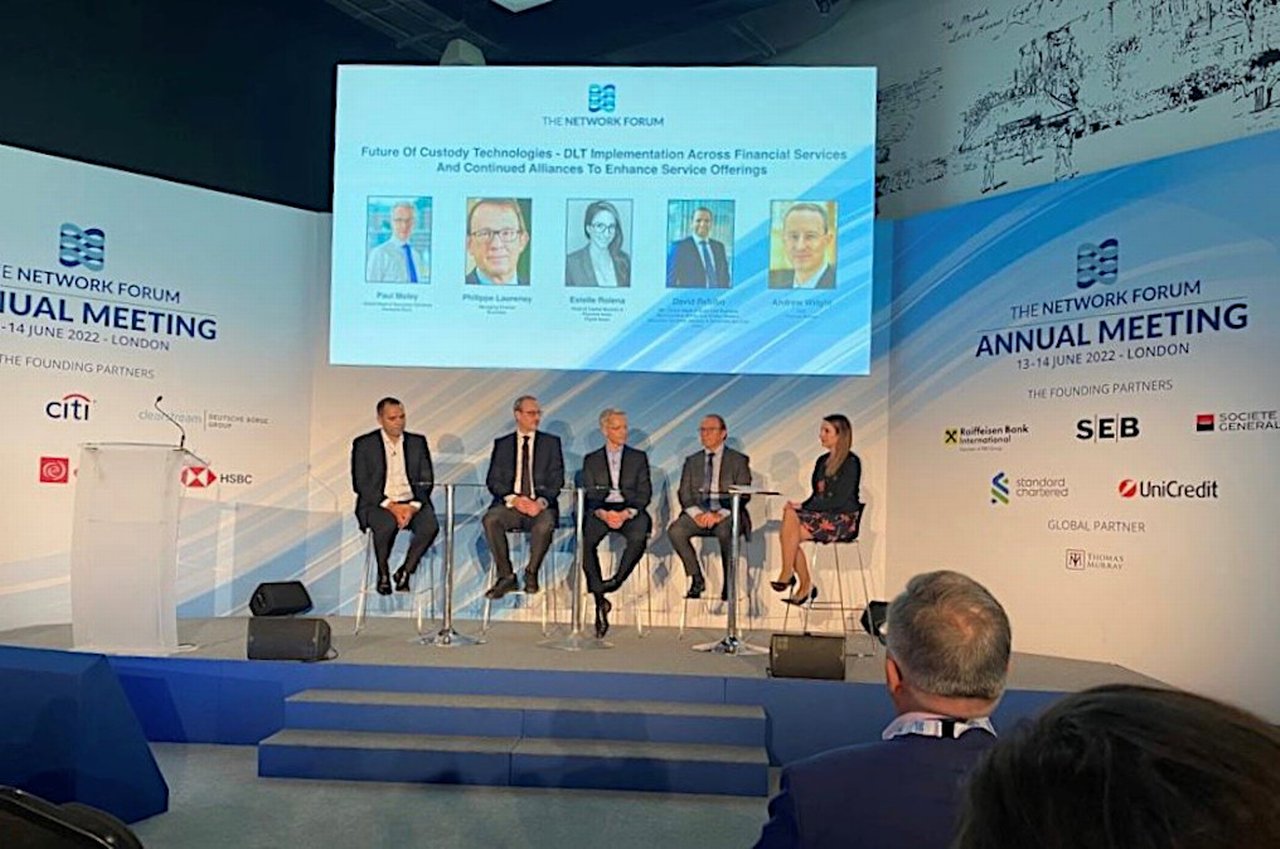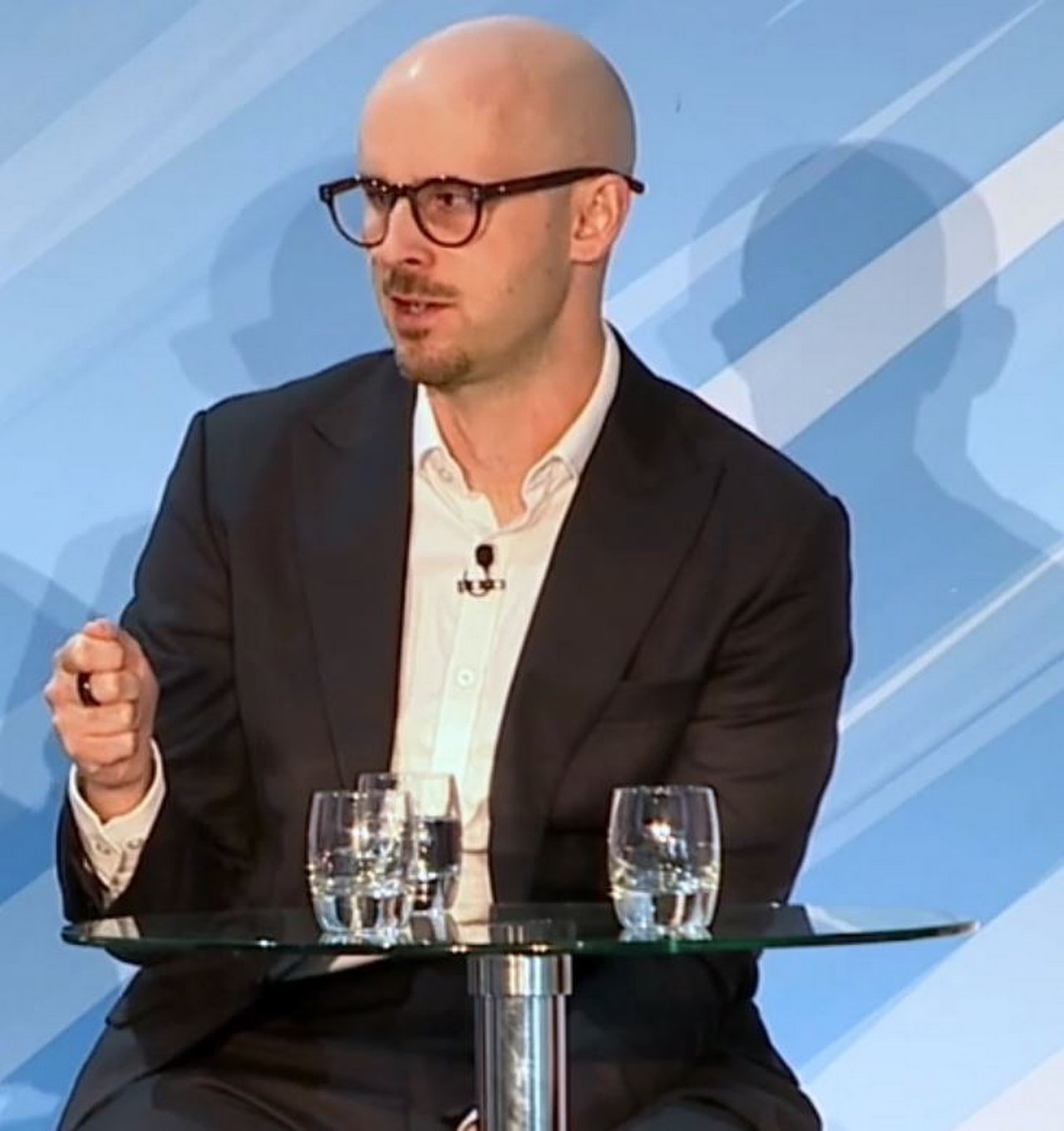30 June 2022
Network managers gathered at The Network Forum in London against a backdrop of regulatory reform, trade settlement compression momentum, digitalisation of assets and processes – and joy to be reconvening at a physical event. flow’s Clarissa Dann reports
MINUTES min read
Two-and-a-half years since Covid-19 first struck, the post-trade function has undergone a metamorphosis, fuelled by digitalisation, the emergence of new asset classes, and industry reform. This shaped various discussions that took place during The Network Forum (TNF) held in London on 13–14 June 2022 after a three-year pandemic-enforced hiatus – this community had not met up since TNF Athens 2019.
By way of backdrop, the conference took place the business day following the S&P500’s descent of 3.5%, dropping to almost 20% from its peak. In short, the operating environment, as noted in one of the early panels, was “challenging”.
Digitalisation must be pragmatic

In the session entitled Future of Custody Technologies - DLT implementation Across Financial Services and Continued Alliances to Enhance Service Offering Deutsche Bank’s Global Head of Securities Services Paul Maley (pictured, centre, above) observed that with stagflation looming amid the geopolitical and macro turmoil, financial institutions are looking for ways to etch out cost savings. “Raw economics drives what we do next, and the question is how we can leverage technology to take costs out?” he asked.
These technology change projects need to have tangible benefits to them
While technological innovation can help facilitate synergies at financial firms, the strategic advantages of such initiatives need to be carefully considered before they are implemented. For instance, Maley warned market participants against establishing Distributed ledger Technology (DLT)-enabled infrastructure in parallel to their legacy systems and processes, as it risks driving up overheads at a time when margins and revenues are shrinking. “Our industry operates as a high fixed cost, low margin business. Creating a new infrastructure on top of old systems will increase costs for end investors, and this will not be tolerated, especially by boards who are focused on the bottom line,” he reflected.
For this reason, financial institutions need to be selective about what projects they embrace. “Focusing on a DLT initiative because it is either intellectually interesting or might make for a nice press release is no longer an acceptable business case. There is widespread industry fatigue around too many Proofs of Concept. These technology change projects need to have tangible benefits to them,” he added.
Driving ahead with data

In financial institutions, particularly the post-trade and custody industry data volumes are growing all the time –from sub-custodians to global custodians, and from global custodians to the buyer side but how can this be leveraged to provide greater efficiency and a better service to clients?
This was the opening question from Clearstream’s Samuel Riley who moderated the Day Two session entitled Leveraging Big Data & Analytics – facing the challenges in delivering quality post-trade data to clients.
“This evolution in technology is a gamechanger in terms of the art of the possible”
According to Chris Daniels, Chief Data Officer at Deutsche Bank (pictured above), getting actionable insights from data has been made infinitely easier by the sharp drop in costs of data storage and compute. He noted industry’s growing willingness to embrace public cloud, having previously relied on-premises infrastructure. Not only does public cloud allow providers to move to a pay-per-use model for data, but they offer well integrated tools and best-in-class security relative to what any institutions could build for themselves, he explained. “This evolution in technology has given us the opportunity to gather vast volumes of data,” he said. From this, banks are joining and preparing the data and turning it into meaningful business intelligence for clients. “This is a gamechanger in terms of the art of the possible,” reflected Daniels. 1
Two examples of successful data analysis outcomes are, shared Daniels, Deutsche Bank’s liquidity dashboard, as well as a tool to help predict trade settlement fails. These have both been warmly received by end institutional clients. Data is also being leveraged by the bank to help augment client relationships. “Our data science teams have been looking at external market data, and then combining it with internal client relationship data. This is then shared with client facing teams, giving them a quantifiable view of client relationships, enabling them to be more proactive,” he continued. Although banks are making excellent progress on data management, Daniels has found that sourcing the right talent can be challenging. “There’s a deep pool of technical talent, in addition to people with business acumen. However, there is scarcity in the market of people who can both understand the business and tackle problems in a data centric way, the translators. This is an area where financial institutions are a bit thin.”
Post-trade ponders on what to do with cryptocurrencies
Is the train just leaving the station with digital assets custody? And who is aboard? TNF panelists in the Day 1 session, Opportunities in digital assets and digital custody: tracking the modernisation of standard custody offering to attract assets/clients agreed that custodians were “on the train” and “the train was moving”. The technology “evolved outside the banking community and cannot be ignored – we have to position ourselves here” said one speaker. The Deutsche Bank white paper, The Triple Revolution in securities post-trade published two weeks after TNF demonstrates the momentum.
The conversation was more pertinent given that cryptocurrencies once boasted a market cap of US$3trn but had since fallen to below US$$1trn. Of that, more than US$200bn was wiped off the cryptocurrency market during the weekend beginning 10 June. 2 Despite the asset class’s recent problems, certain custodians were ensuring they were prepared for demand and are launching solutions to support investors trading crypto.
A very small minority of custodian banks are even developing crypto sub-custody networks in response to institutional investor demand for the digital asset class. This has also been enabled by the Office of the Comptroller of the Currency (OCC), which published a letter back in 2020 seemingly giving authorisation to national banks and federal savings associations to offer cryptocustody to their end clients. A handful of network managers are exploring how best to update their standard sub-custody due diligences following the rise of cryptocustodians – with some making amendments to the Association for Financial Markets in Europe’s Due Diligence Questionnaire (DDQ). 3
Tokenisation is where the interest is at
Activity in tokenisation remains fairly quiet – although there has been a handful of issuances, it is still in its early days. Enabled by DLT, tokenisation can be applied to nearly any fungible or non-fungible asset. This can include a. bond, equity, digitally native financial instruments, etc. A year ago, in the flow article ‘Token power’ we observed, “Agile financial institutions are preparing for a world in which a significant fraction of tangible and intangible assets as well as currencies will be tokenised.”
Tokenisation allows for an asset to be converted into a digital token representation which can be issued, traded and stored on a DLT. These digital tokens can then be split into smaller constituents, making them cheaper to buy than a traditional asset. Retail clients then have a mechanism to invest into markets from which they were previously excluded on cost grounds. However, the industry remains deeply divided over what types of assets should be tokenised.
Deutsche Bank’s Paul Maley told flow at TNF that, in his view, the industry needs to think intelligently about tokenisation, and said he is unconvinced about the intrinsic worth of tokenising conventional assets such as equities, “a market which operates relatively seamlessly already”. Tokenising traditional assets, he added, will require financial market infrastructures FMIs to create new DLT systems, resulting in multiple interfaces, duplicative account structures, liquidity splits and additional costs, which ultimately will be passed onto the end investor or asset holder.
Instead, he believes tokenisation is best suited for private investments – nominally assets which are not listed on the displayed markets. “If you want to do something disruptive, you do not start with the most efficient markets,” he explained. By tokenising private investments (such as private equity, illiquid credit, real estate, infrastructure, precious art, fines wines, etc.) and moving them onto displayed markets, Maley believes they will eventually become more tradeable and liquid. “As these private investments are more observable, banks could also reduce the amount of capital which they need to hold when supporting some of these businesses. There are compelling balance sheet reasons for tokenisation in the longer term,” he noted.
A busy time for settlements in Europe
Trade settlements were a recurrent talking point at TNF. The EU’s Central Securities Depositories Regulation’s (CSDR) Settlement Discipline Regime (SDR) suffered some initial teething issues when it came into effect on February 1, 2022, according to Mike Clarke, Global Product Manager at Deutsche Bank. A detailed explanation of the new regime is set out in the flow article ‘A brave new SDR world?’ and the flow white paper, ‘CSDR: the final countdown’.
TNF panellists acknowledged CSDR’s implementation was hampered by the absence of timely guidance from regulators on some of the rules’ finer requirements along with ongoing problems around messaging. 4 Although settlement rates are largely unchanged since CSDR’s introduction, partial settlements – whereby a transaction is settled in a series of two or more deliveries 5 - are increasing. 6 Despite the early obstacles, Clarke says the industry is now coping well with CSDR.
Earlier in June, the industry was given a respite when the European Securities and Markets Authority (ESMA) confirmed that mandatory buy-ins under CSDR would be postponed for three years following widespread industry criticism of the policy, with regulators being warned that the requirements risked inflaming market volatility. 7 However, Clarke says buy-ins could be reconsidered by ESMA if the industry is unable to improve on settlement discipline (for example by reducing the number of settlement fails).
Shorter settlements – the race is on
Elsewhere, a number of markets – including the US, Canada and India – are looking to obtain efficiencies in post-trade processes through settlement compression – namely by moving from a T+2 settlement model to T+1. In India’s case, this transition is underway although the process will not begin in the US or Canada until 2024. 8 Commenting on the US position at TNF drinks that evening, Deutsche Bank’s Kamalita Abdool, Head of Securities Services Americas underlined the importance of innovation. “The industry will drive to the eventual long-term goal of RTS [real-time settlement], it’s critical that custodians plan and design solutions now to guide our clients in preparation for T+1 in 2024 and then keep innovating to achieve the longer term vision, she said. 9
Delegates heard that market infrastructures in Bangladesh, Mexico, Chile and Brazil are openly discussing a possible move to T+1 as well. However, one speaker said that they doubted the EU will adopt T+1 anytime soon and pointed out the region is still busy implementing CSDR.
A shorter settlement cycle would reduce counterparty and settlement risk, allowing for market participants to post less margin on their trades, in what would provide extensive balance sheet benefits. Conversely, there are hurdles that need to be overcome. Experts at TNF said FX management could be a problem – especially for institutions operating in different time-zones – as it could force firms to pre-fund some of their trades. Another expert warned emerging economies against converging towards a T+1 model just for the sake of it, especially if their underlying FX markets are highly illiquid.
Clarke told flow the shift to T+1 is proving difficult partly because the industry is viewing the issue through the lens of existing technologies and operational processes. Instead, the industry needs to be more forward-looking in terms of how it approaches settlement compression. He said that the end goal for settlement compression must be T+0 and highlighted this can be facilitated through the adoption of disruptive technologies, such as DLT, smart contracts and Central Bank Digital Currencies (CBDCs) or digitalised versions of central bank-issued money. By leveraging such technologies, cross- border transactions could potentially be settled more quickly, culminating in T+0 or even atomic settlement.
Network and ESG – can the two be reconciled?
Environmental, social, governance (ESG) is now firmly embedded in institutional investors’ modus operandi. Data from the Global Sustainable Investment Alliance suggest that the sustainable investment industry is looking after assets totalling around US$35.3trn, having grown exponentially over the last decade, and more recently with COVID-19. 10 As more asset managers and asset owners participate in the burgeoning ESG market, custodians are developing products to support them, including ESG data analytics and benchmarking tools. At a network manager level, the debate around ESG is also gaining momentum.
Already, some network managers are asking their agent banks and FMIs more detailed questions on ESG, a point echoed by Sharon Hunt, Global Head of Network Management at Deutsche Bank, who says ESG is now on the radar at most network teams. While service quality and risk will always be the overriding priorities for network managers when conducting due diligences or reviews on providers, Hunt suggests ESG policies at agent banks will improve if network teams ask them probing questions about it.
The evolving network manager
The post-trade world is likely to see some significant changes over the coming months and years. Efforts to implement settlement efficiency through shorter settlement cycles will continue to gather speed, as will the industry’s adoption of certain new asset classes and ESG. What is not in doubt, however, is that the role of the network manager will continue to evolve as transformation sweeps through the wider securities services’ world. All of this, unsurprisingly, circles back to what the Big Data panelists had emphasised at the start of this packed event – the criticality of data as an essential network management tool.
The Network Forum Annual Meeting took place in London 13-14 June 2022
Sources
1 See Data driven quality (January 2021) at flow.db.com
2 See CNBC (June 14, 2022) Bitcoin drops as much as 17% falling below $23,000 as $200 billion wiped off crypto market over the weekend
3 See https://bit.ly/3AbFYeC at afme.eu
4 See Global Custodian (14 June 2022) Industry experts dissect choppy start to post-CSDR life
5 See Global Custodian (24 May 2022) Partial release: A missing piece to the settlement efficiency puzzle
6 See Global Custodian (14 June 2022) Industry experts dissect choppy start to post-CSDR life
7 See https://bit.ly/3nq8Gkc at esma.europa.eu
8 See India trumpets T+1 settlement at flow.db.com
9 See T+1 settlement reaches America at flow.db.com
10 See World Economic Forum – How sustainable investing will become the norm
Securities services solutions Explore more
Find out more about our Securities services solutions
Stay up-to-date with
Sign-up flow newsbites
Choose your preferred banking topics and we will send you updated emails based on your selection
Sign-up Sign-upSubscribe Subscribe to our magazine
flow magazine is published annually and can be read online and delivered to your door in print
You might be interested in
SECURITIES SERVICES, REGULATION {icon-book}
A brave new SDR world? A brave new SDR world?
With the Central Securities Depositories Regulation (CSDR) Settlement Discipline Regime (SDR) having come into force on 1 February 2022, mandatory buy-ins for market participants that fail to settle a trade within a set period was postponed. flow provides a summary of the impact
A brave new SDR world? MoreSECURITIES SERVICES, REGULATION
Accelerated settlement – the move towards T+0 Accelerated settlement – the move towards T+0
One of the problems with securities settlement happening up to two days following the execution of the trade is the potential for operational and counterparty risk during that window. flow hears from Deutsche Bank’s Mike Clarke and Emma Johnson on the industry and regulatory cooperation, as well as the collaboration needed for instantaneous settlement
TECHNOLOGY, MACRO AND MARKETS, CASH MANAGEMENT
Token power Token power
Despite its volatility, Bitcoin can no longer be ignored and one country has made it legal tender. Where does this leave corporate treasurers and investors – and the financial services industry? flow's Clarissa Dann reports on the prospect of a brave new tokenised world



